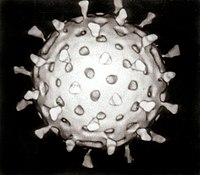
Concurrent infection of Leptospira icterohaemorrhagiae, Hepatozoon canis and Anaplasma phagocytophilum in a Labrador Retriever dog and its therapeutic management
Sign Up to like & getrecommendations! Published in 2019 at "Comparative Clinical Pathology"
DOI: 10.1007/s00580-019-02998-9
Abstract: In this report, concurrent infection of Leptospira interrogans serovar icterohaemorrhagiae, Hepatozoon canis and Anaplasma phagocytophilum in a Labrador Retriever dog and its successful therapeutic management have been described. A 3-year-old female dog was presented with… read more here.
Keywords: anaplasma phagocytophilum; hepatozoon canis; canis anaplasma;

Molecular analysis of Anaplasma phagocytophilum and Babesia divergens in red deer (Cervus elaphus) in Western Austria.
Sign Up to like & getrecommendations! Published in 2017 at "Molecular and cellular probes"
DOI: 10.1016/j.mcp.2016.07.003
Abstract: Wild ungulates may act as reservoirs of various vector borne pathogens that can infect humans and domestic animals. In the present study, blood samples from 196 red deer (Cervus elaphus) from Western Austria (Vorarlberg, Tyrol… read more here.
Keywords: babesia divergens; western austria; anaplasma phagocytophilum; red deer ... See more keywords

Prediction of post translation modifications at the contact site between Anaplasma phagocytophilum and human host during autophagosome induction using a bioinformatic approach.
Sign Up to like & getrecommendations! Published in 2017 at "Molecular and cellular probes"
DOI: 10.1016/j.mcp.2016.09.002
Abstract: Autophagy is crucial for maintaining physiological homeostasis, but its role in infectious diseases is not yet adequately understood. The binding of Anaplasma translocated substrate-1 (ATS1) to the human Beclin1 (BECN1) protein is responsible for the… read more here.
Keywords: becn1; autophagosome induction; anaplasma phagocytophilum;

Co-infection with Babesia divergens and Anaplasma phagocytophilum in cattle (Bos taurus), Sweden.
Sign Up to like & getrecommendations! Published in 2017 at "Ticks and tick-borne diseases"
DOI: 10.1016/j.ttbdis.2017.08.005
Abstract: Babesiosis is a severe disease in cattle worldwide. In Europe, the main causative agent of bovine babesiosis is Babesia divergens. In some areas, this species is reported to have declined or even disappeared, and its… read more here.
Keywords: anaplasma phagocytophilum; infection babesia; infection; babesia divergens ... See more keywords

Simultaneous infection of cattle with different Anaplasma phagocytophilum variants.
Sign Up to like & getrecommendations! Published in 2019 at "Ticks and tick-borne diseases"
DOI: 10.1016/j.ttbdis.2019.05.011
Abstract: Anaplasma phagocytophilum is a tick-transmitted Gram-negative obligate intracellular bacterium that replicates in neutrophil granulocytes. It causes tick-borne fever in cattle and sheep. We report here the case of a 5-year-old cow from Germany with clinically… read more here.
Keywords: infection cattle; anaplasma phagocytophilum; anka; simultaneous infection ... See more keywords

Long-term persistence of Anaplasma phagocytophilum and Ehrlichia muris in wild rodents.
Sign Up to like & getrecommendations! Published in 2020 at "Ticks and tick-borne diseases"
DOI: 10.1016/j.ttbdis.2020.101440
Abstract: Wild animals are reservoir hosts for a number of tick-transmitted agents, and long-term persistence of the agents is a key factor for their effective transmission from animal hosts to ticks. To study the persistence of… read more here.
Keywords: anaplasma phagocytophilum; long term; term persistence; muris ... See more keywords

Development of TEM-1 β-lactamase based protein translocation assay for identification of Anaplasma phagocytophilum type IV secretion system effector proteins
Sign Up to like & getrecommendations! Published in 2019 at "Scientific Reports"
DOI: 10.1038/s41598-019-40682-8
Abstract: Anaplasma phagocytophilum, the aetiologic agent of human granulocytic anaplasmosis (HGA) is an obligate intracellular Gram-negative bacterium with the genome size of 1.47 megabases. The intracellular life style and small size of genome suggest that A.… read more here.
Keywords: anaplasma phagocytophilum; identification; protein translocation; translocation assay ... See more keywords

Ecological factors influencing small mammal infection by Anaplasma phagocytophilum and Borrelia burgdorferi s.l. in agricultural and forest landscapes
Sign Up to like & getrecommendations! Published in 2017 at "Environmental Microbiology"
DOI: 10.1111/1462-2920.13885
Abstract: Small mammals are key components of numerous tick-borne disease systems, as hosts for immature ticks and pathogen reservoirs. To study the factors influencing tick-borne infection in small mammals, we trapped small mammals and collected questing… read more here.
Keywords: anaplasma phagocytophilum; small mammals; small mammal; phagocytophilum borrelia ... See more keywords

Clinical Decision Support Trees Can Help Optimize Utilization of Anaplasma phagocytophilum Nucleic Acid Amplification Testing
Sign Up to like & getrecommendations! Published in 2021 at "Journal of Clinical Microbiology"
DOI: 10.1128/jcm.00791-21
Abstract: Anaplasmosis, a tick-borne illness caused by Anaplasma phagocytophilum (AP), presents with nonspecific clinical symptoms, including fever and headache, and is often accompanied by laboratory abnormalities of leukopenia, thrombocytopenia, and mildly elevated liver function tests (LFTs).… read more here.
Keywords: acid amplification; amplification testing; nucleic acid; anaplasma phagocytophilum ... See more keywords

The Obligate Intracellular Bacterial Pathogen Anaplasma phagocytophilum Exploits Host Cell Multivesicular Body Biogenesis for Proliferation and Dissemination
Sign Up to like & getrecommendations! Published in 2022 at "mBio"
DOI: 10.1128/mbio.02961-22
Abstract: Anaplasma phagocytophilum causes granulocytic anaplasmosis, a globally emerging zoonosis that can be severe, even fatal, and for which antibiotic treatment options are limited. A. phagocytophilum lives in an endosomal-like compartment that interfaces with multiple organelles… read more here.
Keywords: proliferation; phagocytophilum; host; host cell ... See more keywords

SURVEY OF ANAPLASMA PHAGOCYTOPHILUM ANTIBODIES IN CAPTIVE PRZEWALSKI'S HORSES (EQUUS FERUS PRZEWALSKII)
Sign Up to like & getrecommendations! Published in 2017 at "Journal of Zoo and Wildlife Medicine"
DOI: 10.1638/2016-0248r.1
Abstract: Abstract Anaplasma phagocytophilum (formerly Ehrlichia equi) is a tickborne pathogen of domestic horses and the causative agent of equine granulocytic anaplasmosis. After the occurrence of clinical anaplasmosis in a Przewalski's horse (Equus ferus przewalskii) housed… read more here.
Keywords: anaplasma phagocytophilum; ferus przewalskii; phagocytophilum antibodies; equus ferus ... See more keywords